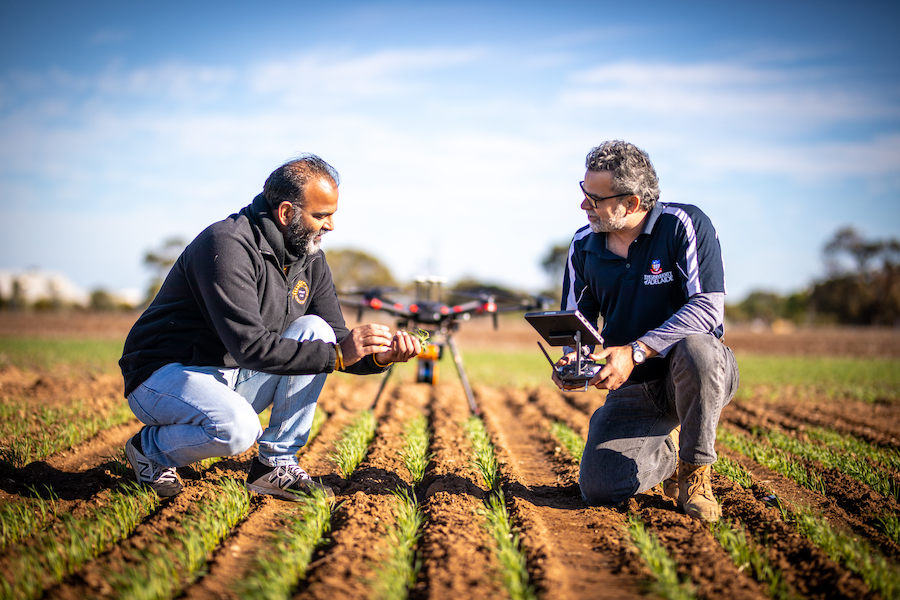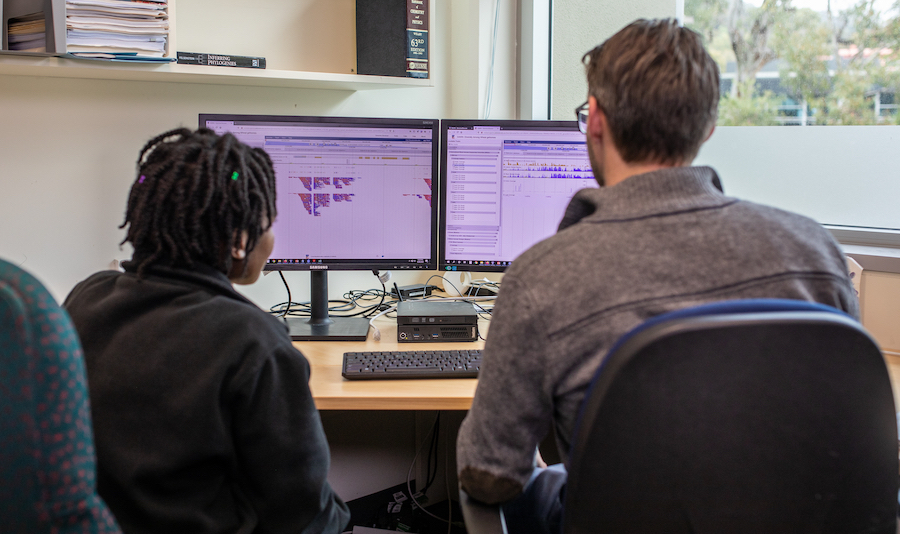A five-year push to innovate wheat breeding tools and germplasm diversity is coming to an end with the expiry of a dedicated research hub – the Australian Research Council (ARC) Industrial Transformation Research Hub for Genetic Diversity and Molecular Breeding for Wheat in a Hot and Dry Climate.
The hub’s industry focus saw important goals achieved, with the initiative also generating momentum for ongoing impacts through an expanding network of national and international collaborations and industry partnerships.
The hub’s exiting director, Associate Professor Stuart Roy, says the focus was on taking cutting-edge innovations from the research space and translating them to meet the needs of wheat breeders. The work spanned wheat-relevant applications from genomics and phenotyping all the way through to drone technology and image analysis.
Alongside developing important new breeding tools, the hub also generated novel genetic diversity to accelerate trait discovery – particularly towards resilience to drought and heat stress and grain protein content.
This work allows an influx of novel genetics into the Australian gene pool, especially with regards to traits for which there is currently too little diversity.
“We wanted to make the whole process of targeting, screening and selecting beneficial new wheat traits simpler, less wasteful and better-integrated to commercial breeding pipelines,” Professor Roy says. “So, while the hub was very much a centre for doing research, its outlook was applied. Researchers worked closely with industry.”
The hub was a collaboration between the University of Adelaide, the University of Sydney, the University of South Australia and industry partners including GRDC, Australian Grain Technologies, InterGrain and LongReach Plant Breeders.
“The combination of people from universities and industry meant that we benefited from bringing together different strengths, capabilities and perspectives,” Professor Roy says. “That integration was woven throughout hub activities, including the supervision and mentoring of PhD students.”
Hub activities were undertaken under five research themes:
1. Drought and heat stress tolerance
Led by Dr Penny Tricker, this theme’s focus was to find new physiological signatures of environmental stress responses and to detect genetic variation within wheat lines with enhanced stress resilience.
“As well as passing on known and newly discovered genetics, we wanted to give breeders better information on when and how to look for tolerance, so we also used new tools for phenotyping these difficult traits,” Dr Tricker says.
Notable success was achieved using a new imaging device – an X-ray CT scanner. It works by combining multiple X-ray measurements taken from different angles to produce three-dimensional, cross-sectional images of wheat heads. These images are processed by algorithms developed by the hub’s collaborators at the Fraunhofer Development Center for X-ray Technology in Fürth, Germany.
This development work has found ongoing applications, with GRDC investing in the purchase of an X-ray CT scanner to be housed at the Plant Accelerator at the University of Adelaide’s Waite Campus. This instrument creates a new phenotyping platform for stress tolerance discovery work for both above and below-ground wheat traits.
Proof-of-concept work undertaken in Germany has seen Australian germplasm screened and tested in field trials.
2. Germplasm development for genetic diversity
In a program led by Dr Melissa Garcia, wheat germplasm sourced from around the world was crossed into two Australian cultivars to generate a new Nested Association Mapping (NAM) population. This population has delivered to industry a broadened wheat gene pool within an Australian-adapted genetic background.
The NAM population has undergone field evaluation by breeders at sites in SA, Western Australia and New South Wales over several years. It also attracted interest internationally, with the lines grown in the UK and India.
The resulting field performance data from multiple sites and seasons is driving ongoing discovery work to associate the introduced exotic DNA with valuable new traits.
Using the hub’s dedicated drought and heat stress phenotyping facility, this kind of genomic analysis identified a number of DNA fragments associated with combined drought and heat stress tolerance. These new genetics have been crossed into four commercial varieties that are undergoing field assessment by industry partners.
3. High-throughput phenotyping tools
Led by Dr Ramesh Raja Segaran, this research theme focused on drone-based ways to capture data from field trial plots alongside the development of algorithms to process the images in ways that are meaningful to breeding programs.

Sanjiv Satija and Dr Ramesh Raja Segaran (Hub Program Leader) discussing the use of drones in the field. Photo: Tim Standing, DayLight Breaks
This involved working with an industry partner to use readily available, off-the-shelf drone technology. Methods were then developed to allow for consistent flight patterns that are needed for comparisons of trial plots over time.
The use of hyperspectral cameras meant that data spanned the visible and infra-red spectrum, generating a mass of data. The hub researchers ensured that the capacity was created to extract valuable information without getting bogged down by the size of the datasets. This involved image analysis techniques to create algorithms that can score breeding lines for a range of important characteristics including establishment, plant growth or to count grain heads.
“We wanted to take drone and imaging technology from a promising research tool to a platform capable of routine and targeted plot analysis while creating the basis for ongoing development of algorithms,” Professor Roy says.
4. Linkage of yield and grain nitrogen
Led by Dr Mamoru Okamoto, this research theme translated knowledge of how wheat takes up, stores and mobilises nitrogen. The researchers were able to understand the genetic linkage that causes a common industry problem: the association of higher yields with grain that contains lower protein content.
This involved working through physiological, molecular and genetic modes of analysis to ultimately identify the linked genes, develop DNA markers and devise ways to break the link.
That knowledge has now been adopted by industry and is being used to develop breeding material capable of both high yields and high grain protein content.
5. Genomics for breeding
Led by Dr Ute Baumann, this research theme developed tools to open up the use of information about the wheat genome to capture the existing diversity of Australia’s wheat breeding gene pool.
Among the outputs is a bioinformatics tool called the Diversity Among Wheat Genomes program, used to visualise wheat’s large and complex genome specifically around data important to Australian wheat breeding.

Sanjiv Satija and Dr Ramesh Raja Segaran (Hub Program Leader) discussing the use of drones in the field. Photo: Tim Standing, DayLight Breaks
The backbone is provided by the sequenced wheat reference genome. To this backbone are pinned divergent sequences identified in Australian cultivars. This creates a bird’s-eye view of genomic regions where diversity is abundant and where it is lacking.
Adding data from the exotic wheats in the NAM population means that these differences in chromosome regions can be identified and researchers can find new genetic markers associated with traits of interest.
This strategy facilitates bringing extra diversity into agronomically important genomic regions for new traits and trait combinations related to drought and heat stress tolerance. Professor Roy says an important consequence is that genomics research can now be more targeted.
Conclusions
Besides utilising existing wheat science to develop important new wheat breeding tools, Professor Roy says the hub also fostered collaborations that will continue to roll out gains for years to come. These include:
- the ARC Centre for Nanoscale BioPhotonics for nanoscale sensors to detect oxidative stress in plants;
- the University of Tasmania enhancing imaging capacity to phenotype water flow through stressed plants; and
- the University of Illinois’ Crops in Silico project to generate computer simulations integrating wheat physiological traits, genomics, metabolomics and the environment.
“The hub delivered wheat germplasm with enhanced diversity for drought and heat stress tolerance,” Professor Roy says.
“This material is being grown at multiple sites by breeders, and their ability to screen this material and explore its genetics has been enhanced.”
More information: Stuart Roy, stuart.roy@adelaide.edu.au

























































